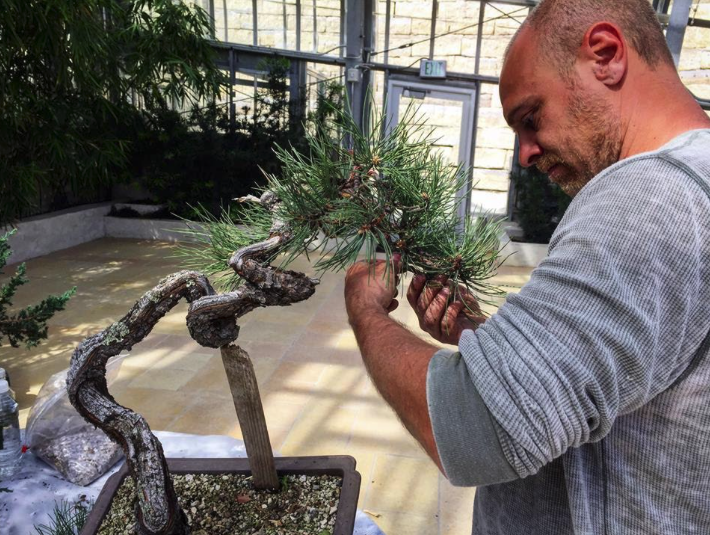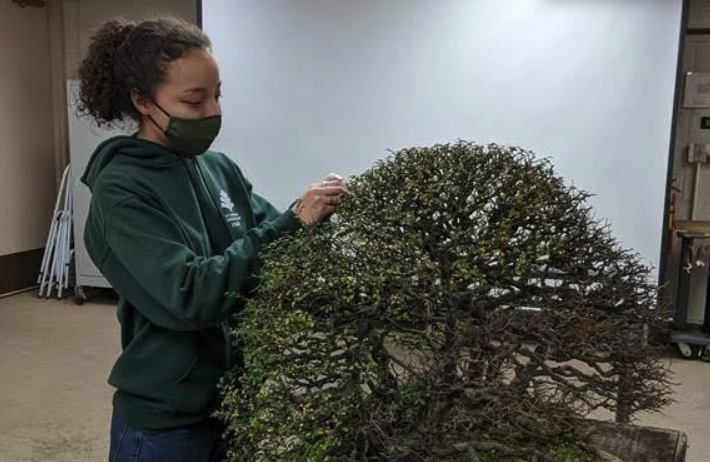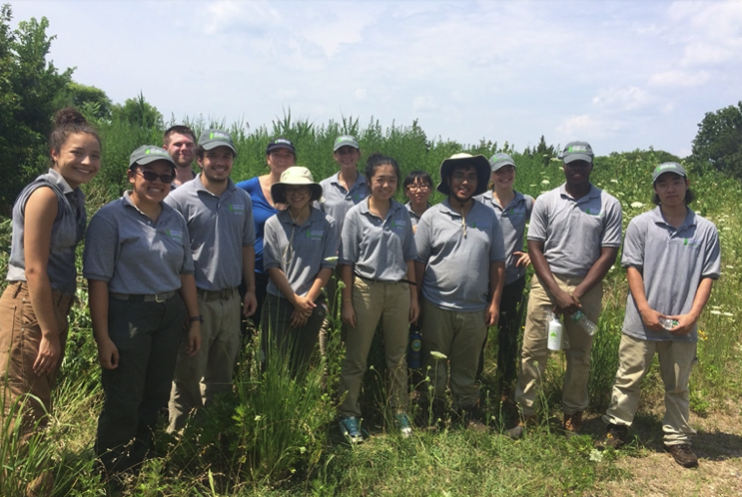Sophia and Museum volunteer LeAnn Duling repotting a buttonwood from Mary Madison
Since the beginning of my First Curator’s Apprenticeship at the National Bonsai and Penjing Museum in the spring of 2020, I’ve had the opportunity to learn the skills and practices needed to maintain such a stately and magnificent collection of bonsai trees.
While working on the trees, like daily pruning or watering, I have also been tackling an individual project. My focus was to study and select National Arboretum plant introductions, or species that were originally grown elsewhere, and evaluate their potential for widespread use in creating bonsai material. The goal of this project is to one day display these trees as bonsai at the National Bonsai and Penjing Museum in a collection formed entirely from U.S. National Arboretum plant introductions.
The two species that I had initially selected specifically are Prunus campanulata ‘Abigail Adams’ and Lagerstroemia ‘Tonto.’ While working on the trees, my mentors and I discovered that the graft of Prunus campanulata was not actually an Arboretum introduction. But we are in the process of obtaining a new graft of Abigail Adams that can hopefully be a success soon.
On the other hand, Lagerstroemia ‘Tonto’ looks like a promising specimen that will continue to form new roots and successfully live on for Museum staff to prune and wire branches for styling. Both trees provided a beneficial learning experience in handling grafted introduced species and what is necessary for any species to be potential bonsai material. Just as my project shows, plant introduction species can be explored and tested as bonsai material for many years to come.
As an apprentice gifted with the opportunity to learn about the art of bonsai and work alongside such an incredible team, my knowledge of woody and herbaceous plant species has grown tremendously throughout my time here. The Museum, the Arboretum and its plant introduction program have shown me just how much more there is to learn and discover.
Thanks to the Museum, I’ve experienced learning moments unique to this apprenticeship, such as what it means to have an eye for bonsai and penjing needs, how to wire a branch successfully for better structure and aesthetic or how to patiently prune and thin trees, making sure foliage is visually even throughout.
Some of my favorite memories have been with visitors who have seen me water the collections. Each day I received so many questions about the trees. As an apprentice, it was not only rewarding but also some of the best practice of my knowledge thus far.
It has also been an absolute pleasure meeting and getting to know the volunteers who dedicate their time to the Museum each week, learning how they got started in bonsai and their personal experiences. They have been some of the kindest and most helpful people I have ever spoken to, and it is very comforting to learn from such a large community of people who also love to practice and work on bonsai as well.
I owe many of my thanks to the Museum staff, especially Michael and Andy. They have been some of the most insightful and talented people I’ve ever had the privilege to learn from. Not only are they both extremely knowledgeable in the art of bonsai, but they are both very patient and caring in their field and offer a range of information, practices and teachings for myself and volunteers alike. I intend to hold onto my experiences here and use them to start my own bonsai collection and as references for years to come.
I will be continuing to put my passion for trees to work, but on a much different scale. I have accepted a training arborist position with The Davey Tree Expert Company and hope to get my arborist certification. I am very excited and happy that my work with trees will continue, and I’ll be sure to visit and check on the trees at the museum as often as I can.
If it were not for the opportunity I was granted at the National Bonsai and Penjing Museum and U.S. National Arboretum, I’m not quite sure where I’d be. But I am eternally grateful for all they have given me and will continue to study bonsai.
“Sophia helped to maintain the National collection of bonsai and penjing through the pandemic, dependably carrying on an essential tradition of bonsai training that has allowed our specimens to thrive for centuries. Sophia received a job at a multinational tree care company. An opportunity that will allow her to apply her bonsai skills to training trees of a much larger scale. That is something we can all benefit from!” — Michael James, Curator.
The National Bonsai Foundation established the First Curator’s Apprentice position in 2011 in recognition of the Museum’s first curator, Robert Drechsler (Bonsai Bob), for his many years of service. This apprenticeship supports bonsai scholarship and dedication to future generations. This year’s apprenticeship was funded by the National Bonsai Foundation, with the generous support of Mrs. Barbara Hall Marshall and the Joseph & Sophia Abeles Foundation.
After starting in February 2020 (and having some interruption relating to COVID-requirements), Sophia Osorio’s last day as Apprentice was Sept. 11, 2021. Wish her luck in her next endeavors through the comments section below.


















